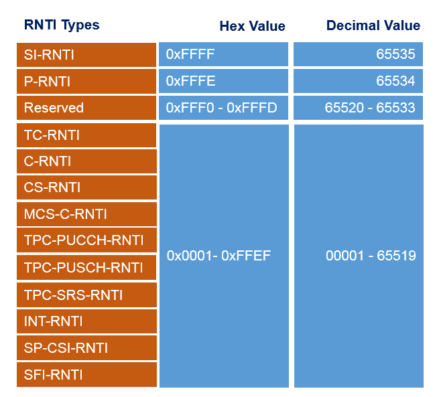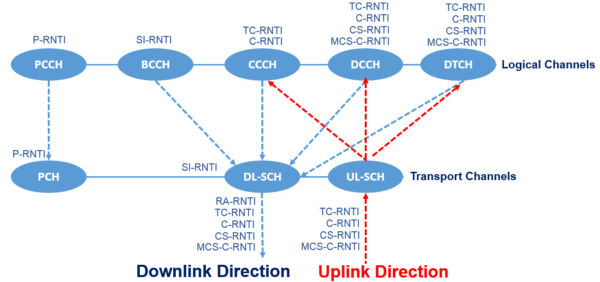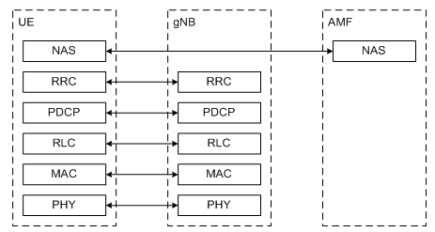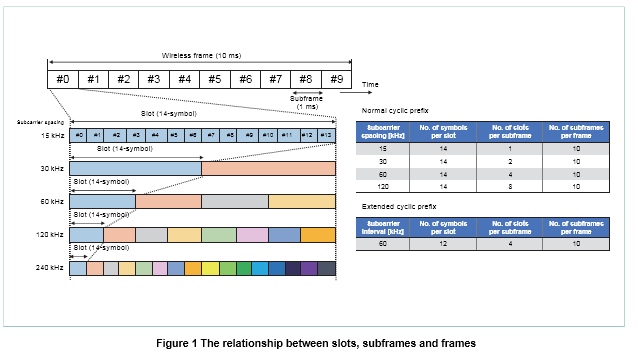5G NR Radio Network Temporary Identifier (RNTI)
5G NR Radio Network Temporary Identifier (RNTI)
RNTI stands for Radio Network Temporary Identifier. RNTIs are used to differentiate/identify a connected UE in the cell, a specific radio channel, a group of UEs in case of paging, a group of UEs for which power control is issued by the eNB, system information transmitted for all the UEs by 5G gNB.
RNTI is an 16-bit identifier and its value depends on type of RNTI. The value is discussed in subsequent section of this post.
Types of RNTI
As per 3GPP specifications 38.321 following is the list of RNTI defined for New Radio. Many of the RNTIs are similar to LTE while some new RNTIs has been introduced to support new uses defined for NR.
- SI-RNTI : System Information RNTI
- P-RNTI : Paging RNTI
- RA-RNTI: Random Access RNTI
- TC-RNTI : Temporary Cell RNTI
- C-RNTI : Cell RNTI
- MCS-C-RNTI : Modulcation Coding Scheme Cell RNTI
- CS-RNTI : Configured Scheduling RNTI
- TPC-PUCCH-RNTI :Transmit Power Control-PUCCH – RNTI
- TPC-PUSCH-RNTI :Transmit Power Control-PUSCH – RNTI
- TPC-SRS-RNTI : Transmit Power Control-Sounding Reference Symbols – RNTI
- INT-RNTI : Interruption RNTI
- SFI-RNTI : Slot Format Indication RNTI
- SP-CSI-RNTI : Semi-Persistent CSI RNTI
- System Information RNTI (SI-RNTI) is used for broadcast of system information. It is a common RNTI meaning that, it is not allocated to any UE explicitly and common to all UEs in the cell. SI-RNTI is of 16-bit in length and its value is fixed to 65535 (0xFFFF). A single SI-RNTI is used to address all SI messages.Broadcast of System Information uses BCCH logical channel which is then mapped to DL-SCH transport channel which intern mapped to PDSCH physical channel. The UEs should know the scheduling information for PDSCH which is carrying System Information. The required scheduling information is contained in DCI (Downlink Control Information) whose CRC is scrambled by SI-RNTI .The UE starts decoding PDCCH scrambled with SI-RNTI at the start of SI Window (for the concerned SI message) until the end of the SI window, or until the SI message was received excluding the following subframes.
- Paging RNTI (P-RNTI) is used by the UEs for the reception of paging. It is a also common RNTI meaning that it is not allocated to any UE explicitly.P-RNTI is of 16-bit in length and its value is fixed to 65534 (0xFFFE). Paging message is carried by PCCH logical channel which is mapped to PCH transport channel. The PCH transport channel is mapped to PDSCH physical channel. The gNB scrambles PDCCH’s CRC with P-RNTI for transmission of PDSCH that carries paging information DCI Formats which carries scheduling information for paging.
- Random Access RNTI (RA-RNTI) is used during Random Access procedure, the gNB’s MAC generates Random Access Response (RAR) as a response to the Random Access Preamble transmitted by the UE. RAR is transmitted on DL-SCH transport channel which intern is mapped to PDSCH. The gNB scrambles PDCCH’s CRC with RA-RNTI for transmission of PDSCH that carries RAR(s). RA-RNTI can be addressed to multiple UEs, i.e., multiple UEs might decode PDCCH scrambled by the same.
- Temporary Cell RNTI (TC-RNTI) is also used during Random Access procedure, the gNB’s MAC generates Random Access Response (RAR) as a response to the Random Access Preamble transmitted by the UE. The MAC RAR contains Temporary C-RNTI. During contention based random access procedure, the UE stores received Temp C-RNTI (received in RAR) and uses it during random access procedure. The UE shall discard the Temporary C-RNTI value received in RAR during non-contention based random access procedure.The UE shall use Temp C-RNTI for scrambling of msg3 (PUSCH corresponding to RAR grant) and it’s retransmissions. During contention based RA procedure, the UE monitors PDCCH scrambled with Temp C-RNTI. The Temp C-RNTI is promoted to C-RNTI for a UE which detects RA success and does not already have a C-RNTI.
- Cell RNTI (C-RNTI) is a unique identification used for identifying RRC Connection and scheduling which is dedicated to a particular UE. The gNB assigns different C-RNTI values to different UEs. The gNB uses C-RNTI to allocate a UE with uplink grants, downlink assignments, etc. C-RNTI is used by gNB to differentiate uplink transmissions (e.g. PUSCH, PUCCH) of a UE from others.
- Transmit Power Control RNTI (TPC RNTI ) is used for uplink power control purpose. There are three types of TPC-RNTI namely TPC-PUSCH-RNTI, TPC-PUCCH-RNTI and TPC-SRS-RNTI. Normally TPC RNTI is assigned to a group of UEs. gNB may configure the UE with TPC-PUSCH-RNTI, TPC-PUCCH-RNTI and TPC-SRS-RNTI via higher layer signalling (RRC).
RNTI Values and Mapping to Channels
As pointed at starting of this blog post, a RNTI is an 16-bit identifier, where each RNTI has a specific value or a range defined by specifications depending on the type of RNTI. The hex and decimal values for each type of RNTI is depicted below.
These RNTIs are associated with NR logical and Transport channel and shown below:
RNTI Usage
Following picture depicts the usage of RNTI as per 3GPP 38.321 Table 7.1-2
Reference:
- TS 38.321 NR; Medium Access Control (MAC) protocol specification (Release 15)






